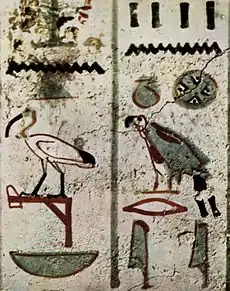Townsite-city-region (hieroglyph)
The Egyptian hieroglyph Townsite-city-region is Gardiner sign listed no. O49 for the intersection of a town's streets. In some Egyptian hieroglyph books it is called a city plan.[1]
| Townsite City Crossroads "Intersection" in hieroglyphs | ||
|---|---|---|

It is used in Egyptian hieroglyphs as a determinative in the names of town or city placenames. Also, as an ideogram in the Egyptian word "city", niwt.
Origin and history
Betrò uses the Libyan Palette as her extensive explanation of the City Plan. The Libyan Palette contains seven cities, fortress-protected; the seven cities are identified inside an approximate–circular–enclosure with iconography, with some signs to become hieroglyphs, and similarly identified externally with the similar hieroglyphic iconography, also to be used as hieroglyphs. (see list: Libyan Palette)
The Fortress (hieroglyph) iconography was still being used in Ramesses II's time to identify placenames of defeated locations, referring to the Nine bows. The Fortress (hieroglyph) is shown in three non-Gardiner's sign listed forms-(all vertical); the category is Buildings and Parts of Buildings.[2]
See also
References
- Betrò, 1995. Hieroglyphics: The Writings of Ancient Egypt, "City Plan", p. 190.
- Budge, 1978, (1920) An Egyptian Hieroglyphic Dictionary, "fortress", (no. 35, 36, 37), section: BUILDINGS AND PARTS OF BUILDINGS, p. cxxvii-cxxx
- Betrò, 1995. Hieroglyphics: The Writings of Ancient Egypt, Betrò, Maria Carmela, c. 1995, 1996-(English), Abbeville Press Publishers, New York, London, Paris (hardcover, ISBN 0-7892-0232-8)
- Budge. An Egyptian Hieroglyphic Dictionary, E.A.Wallace Budge, (Dover Publications), c 1978, (c 1920), Dover edition, 1978. (In two volumes, 1314 pages.) (softcover, ISBN 0-486-23615-3)
- Schulz, Seidel, 1998. Egypt: The World of the Pharaohs, Editors, Regine Schulz, Matthias Seidel, Könemann Verlagsgesellschaft mbH, Cologne, English translation version, 538 pages. (hardcover, ISBN 3-89508-913-3)